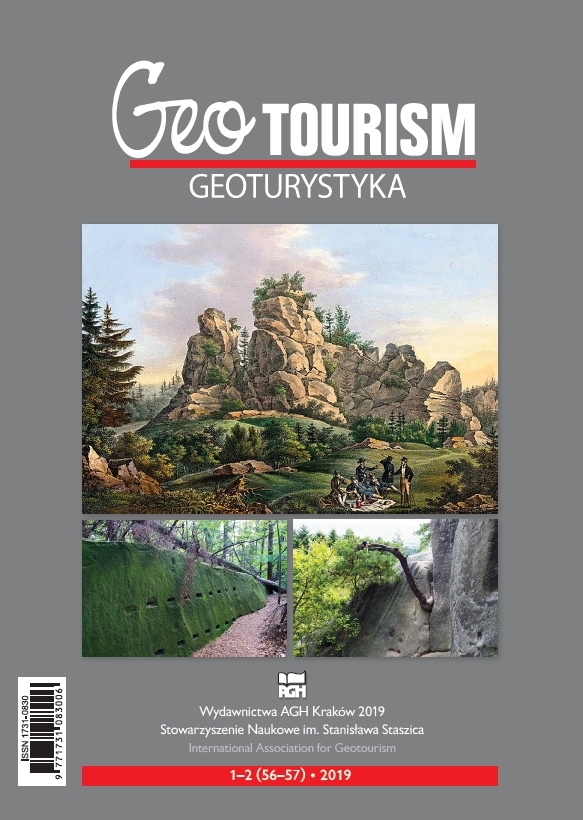Rocky forms in the Yamna Sandstone (Skyba Nappe, Outer Carpathians, Ukraine)
DOI:
https://doi.org/10.7494/geotour.2019.56-57.3Keywords:
sandstone rocky forms, tors, Eastern Outer Carpathians, Yamna Sandstone, Skyba Nappe, thick-bedded sandstone complex, geotourismAbstract
Interesting objects – the rocky forms and waterfall thresholds, built of Yamna Sandstone occur in the vicinity of Skole town. Beside the esthetic positive aspects related the morphological variety of the rocky forms and occurrence of the diversified weathering structures, the objects have a substantial cognitive value encompassing the lithology and sedimentological processes of the thick-bedded turbidites. The sandstone rocky forms usually occur in the groups distributed on slopes and forming so-called rocky towns. Their number and distribution allow observation of the changing structural and textural features both lateral and vertical within the 100-m thick composed profiles. The excellent degree of rocks outcropping, variety of structural and textural features and spectrum of possible observations indicates the high geotouristic potential of the investigated objects.
Downloads
References
Alexandrowicz Z., 1970. Skałki piaskowcowe w okolicy Ciężkowic nad Białą. Ochrona Przyrody, 35: 281–335.
Alexandrowicz Z., 1977. The origin of sandstone tors in the Polish Western Carpathians. Bulletin de L’Academie Polonaise des Sciences, Serie des Sciences de La Terre, 25: 83–90.
Alexandrowicz Z., 1978. Sandstone tors of the Western Flysch Carpathians. Prace Geologiczne Komisji Nauk Geologicznych Polskiej Akademii Nauk Oddział w Krakowie, 113: 1–86.
Alexandrowicz Z., 2006. Framework of European geosites in Poland. Nature conservation, 62: 63–87.
Alexandrowicz Z., 2008. Sandstone rocky forms in Polish Carpathians attractive for education and tourism. Przegląd Geologiczny, 58: 680–687.
Alexandrowicz Z. & Poprawa D., 2000. Ochrona georóżnorodności w polskich Karpatach. Państwowy Instytut Geologiczny, Warszawa.
Bąk B., Laskowicz I., Radwanek-Bąk A. & Szeląg A., 2006. Georóżnorodność i atrakcje geoturystyczne województwa małopolskiego. Przewodnik i Mapy geoturystyczne. Państwowy Instytut Geologiczny – Państwowy Instytut Badawczy, Warszawa.
Bezvynniy V. P., Biletski S.V. & Bobrov O.B., 2006. Volume I. In: Kalinin V. I., Gurskiy D.S. & Antakova I.V. (eds.), Geologichni pam’jatky Ukrai’ny (Geological Landmarks of Ukraine), DIA, Kiev.
Bubniak I.M. & Solecki A.T., 2013. Przewodnik geoturystyczny po szlaku GEO-KARPATY, Krosno–Borysław–Jaremcze. Ruthenus, Krosno.
Gavryshkiv G., Zhukov S., 2009. Mineralogy and geochemistry of sandstone concretions from the Paleocene Yamna Suite of the Ukrainian Carpathians. Mineralogical Review, 59(1): 75–82.
Golonka J., Ślączka A., Waśkowska A., Krobicki M. & Cieszkowski M., 2013. Budowa geologiczna zachodniej części polskich Karpat zewnętrznych. In: Krobicki M. & Feldman-Olszewska A. (red.), Głębokomorska sedymentacja fliszowa – sedymentologiczne aspekty historii basenów karpackich. V Polska konferencja Sedymentologiczna. Państwowy Instytut Geologiczny – Państwowy Instytut Badawczy, Warszawa, 11–62.
Hnylko O., 2017. Structure of the lateral extrusion in the Carpathians. Geodynamics, 1: 16–25.
Jankowski L., Kopciowki R. & Ryłko W., 2004. Geological Map of the Outer Carpathians: Borderlands of Poland, Ukraine and Slovakia: 1: 200 000. Polish Geological Institute, Warszawa.
Kugutiak M.V., 2015. Bubnyshche. Skelʹne svyatylyshche Velykoyi Bohyni v Karpatakh – (Rocky sanctuary of the Great Goddess in the Carpathians). Manuskrypt, Ivano-Frankivsk.
Matenco L., Krézsek C., Merten S., Schmid S., Cloetingh S. & Andriessen P., 2010. Characteristics of collisional orogens with low topographic build‐up: an example from the Carpathians. Terra Nova, 22: 155–165.
Myatlyuk E.V., 1970. Foraminifery flishevykh otlozheniy Vostochnykh Karpat (mel-paleogen) (Foraminifera of the flysch deposits of the Eastern Carpathians (Cretaceous-Paleogene)). Nedra, Leningrad.
Nakapelyukh M., Bubniak I., Bubniak A., Jonckheere R. & Ratschbacher L., 2018. Cenozoic structural evolution, thermal history, and erosion of the Ukrainian Carpathians fold-thrust belt. Tectonophysics, 722: 197‒209.
Paul, K.M. & Tietze, E. 1877. Studien in der Sandsteinzone der Karpathen. Jahrbuch der geologischen Reichsanstalt, Wien, 27: 33–130.
Picha F. & Golonka J., 2006. The Carpathians and their foreland: Geology and hydrocarbon resources. American Association of Petroleum Geologists, Memoir, 84: 1–600.
Rozhko M.F., 1996. Tustan Medieval cliff-side fortress. Naukova Dumka, Kyiv. Rozhko M.F., 2016. Architecturу and defensive system of the Ukrainian Carpathians in the Princely era (Architecture and defense system of the Ukrainian Carpathians in the princely era). BaK, Lviv.
Senkovskyi Y.M., Grygorchuk K.G., Koltun Y.V., Gnidets V.P., Radkovets N.Y., Popp I.T., Moroz M.V., Moroz P.V., Rever A.O., Gavryshkiv H.Y., Gayevska Y.P., Kohan O.M., Koshil’ L.B. 2018. Lithogenesis of sedimentary complexes of Tethys Ocean: Carpathian-Black Sea Segment. Naukova dumka, Kyiv.
Słomka T. (red.), 2013. Katalog obiektów geoturystycznych w obrębie pomników i rezerwatów przyrody nieożywionej (The catalogue of the geoturist sites in nature reserves and monuments). AGH Akademia Górniczo-Hutnicza. Wydział Geologii Geofizyki i Ochrony Środowiska. Katedra Geologii Ogólnej i Geoturystyki, Kraków.
Stadnik R. & Waśkowska A., 2015. Sedimentary indicators of a deep sea environment, in the sandstones of rocky forms, from the Ciężkowice-Rożnów Landscape Park (Outer Carpathians, Poland). Geotourism, 40–41: 37–48.
Strzeboński P., 2009. Sandstone-conglomerate rocky forms – more than a tourist attraction. Geotourism, 16–17: 49–60.
Vashchenko V., Turchynov I. & Heneralova L., 2017. Heolohichni resursy turyzmu pryrodnoho kompleksu dolyny r. Kam`yanka (Ukrayins ʹki Karpaty) – heopark “Kam`yanka” // Visnyk Lʹvivsʹkoho universytetu (Geological resources of tourism of natural complex of dolina R. Kamyanka (Ukrainian Carpathians) – Geopark “Kamyanka”). Visnyk of the Lviv University, Series Geology, 31: 130–159.
Vyalov O.S., 1961. Paleogenovyy flish severnogo sklona Karpat (Paleogene flisch of the Northern Slope of the Carpathians). AS USSR, Kyiv.
Vyalov O.S., Gavura S.P. & Danysh V.V., 1981. Istoriya geologicheskogo razvitiya Ukrainskikh Karpat (History of geological development of Ukrainian Carpathians). Naukova Dumka, Kiev.
Vyalov O.S., Gavura S.P., Danysh V.V., Leshchuch R.J., Ponomaryova L.D., Romaniv H. M., Smirnov S.S., Tsarnenko P.N., Lemishko O.D. & Tsizh I.T., 1988. Stratotipy melovykh i paleogenovykh otlozheniy Ukrainskikh Karpat (Stratotypes of Cretaceous and Paleogene deposits of the Ukrainian Carpathians). Naukova Dumka, Kiev.
Wdowiarz J., 1947. Płaszczowina skolska w regionie Czeremoszu (The Skole nappe in the region of the Czeremosz). Annales Societatis Geologorum Poloniae, 17: 153–193.
Downloads
Published
How to Cite
Issue
Section
License

The content of the journal is freely available according to the Creative Commons License Attribution 4.0 International (CC BY 4.0).


